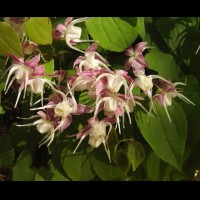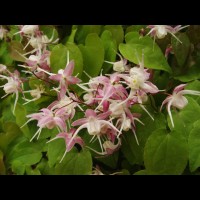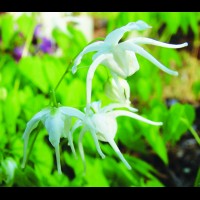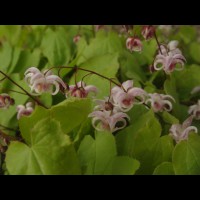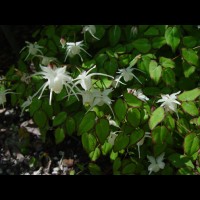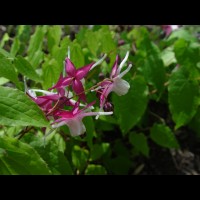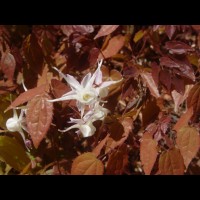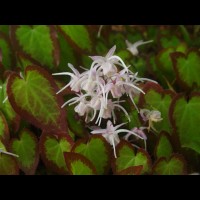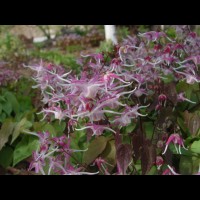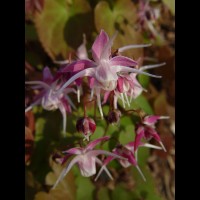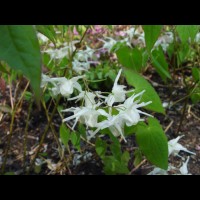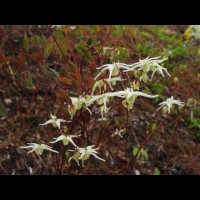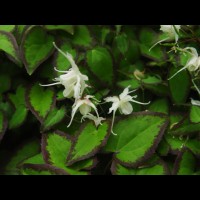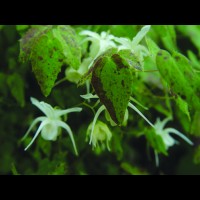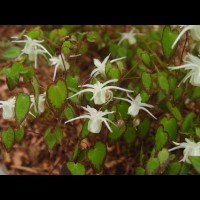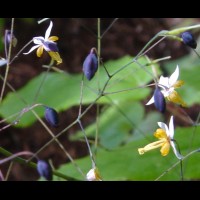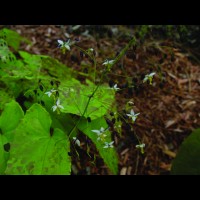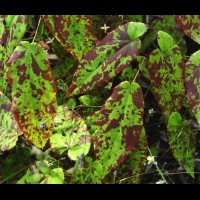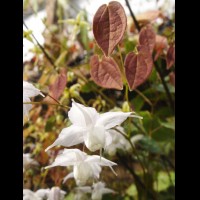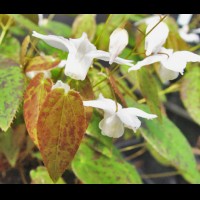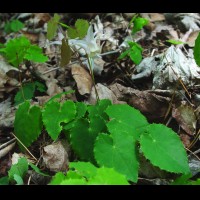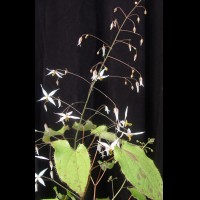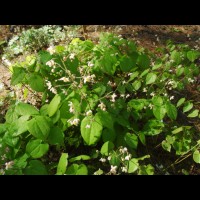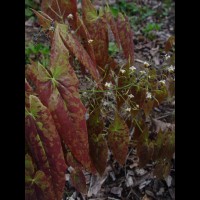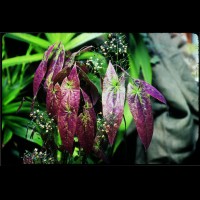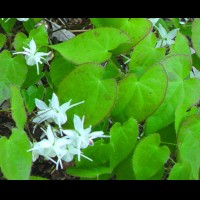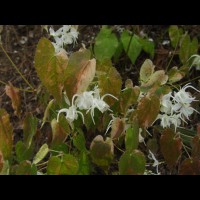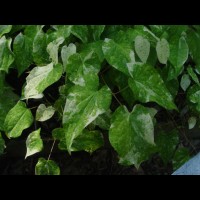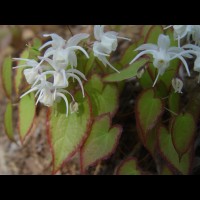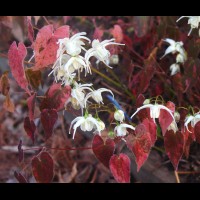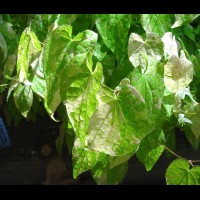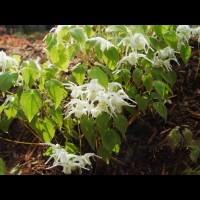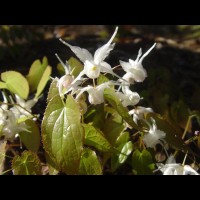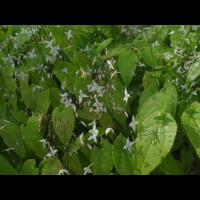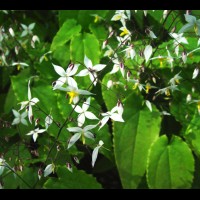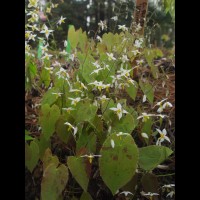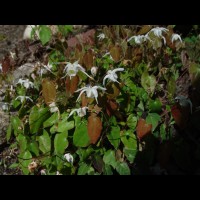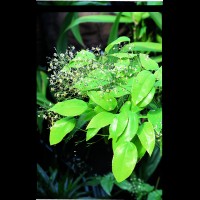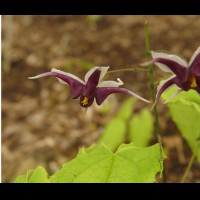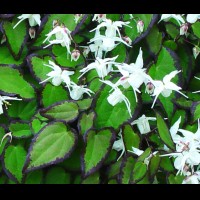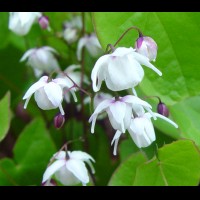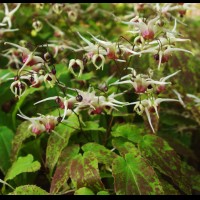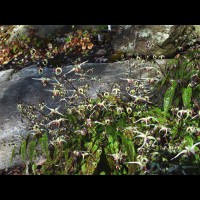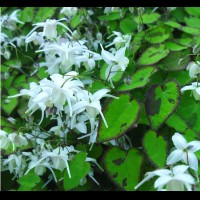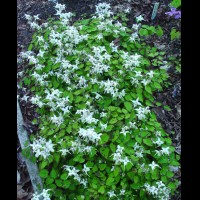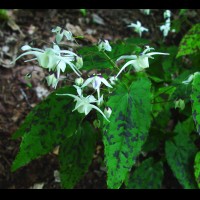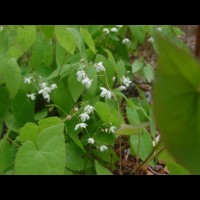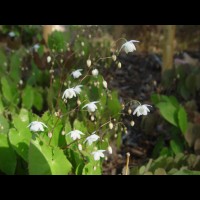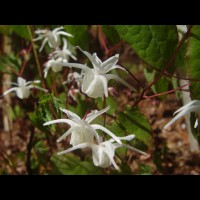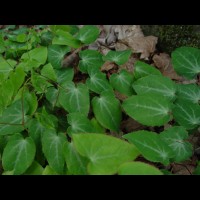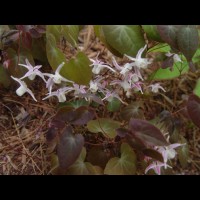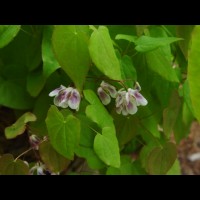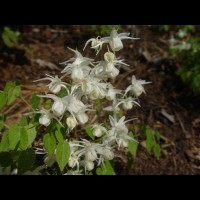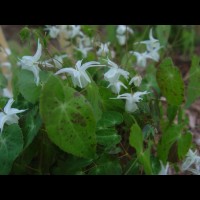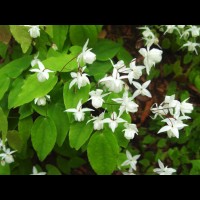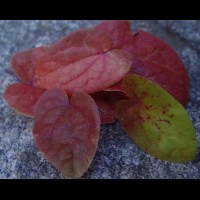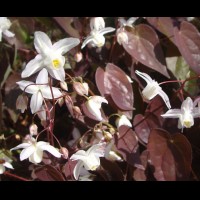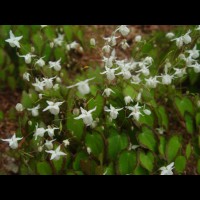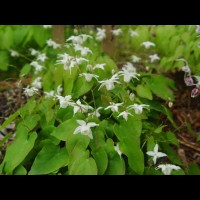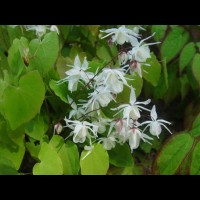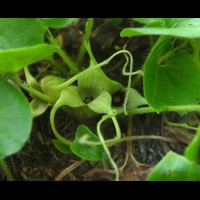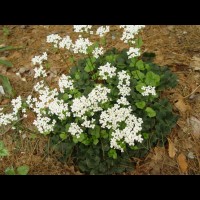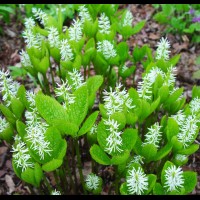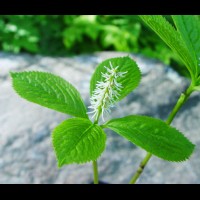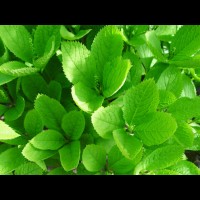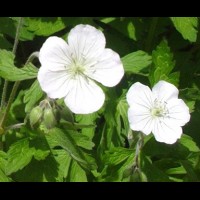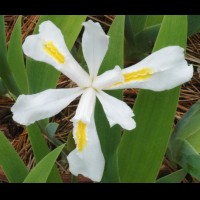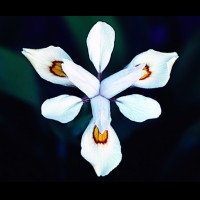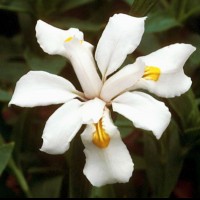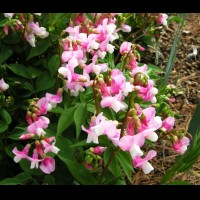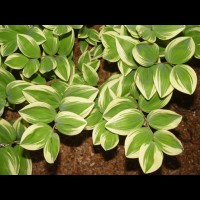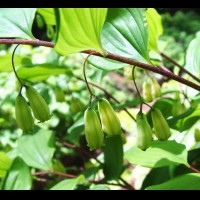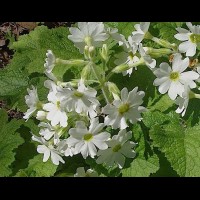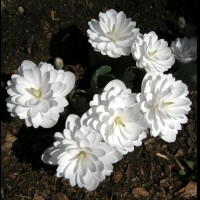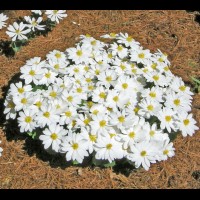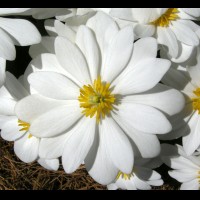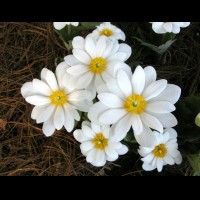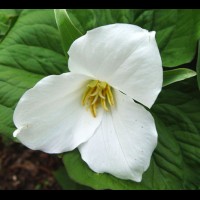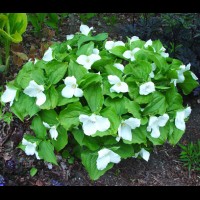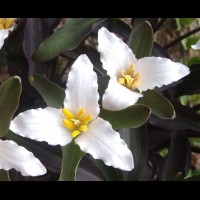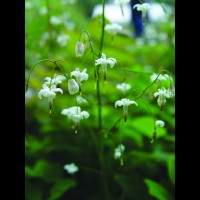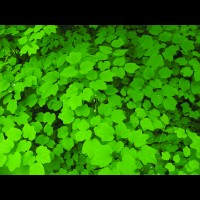Epimedium acuminatum
Epimedium acuminatum (Cc. 930001)
This species was originally collected by Mikinori Ogisu in the late 1970’s, and first introduced into the U.S in 1982. Several new introductions have arrived since, but this clone is the most dwarf at 8-10”. Relatively small evergreen leaflets, bright green in spring with shadows of purple flecks. The large flowers have white inner-sepals and grape-purple petals/spurs. Foliage 8-10" high at maturity.
Epimedium brevicornu
Epimedium brevicornu (Several clones/Cc. numbers)
A beautiful hardy, deciduous species native to the northern regions in China where Epimediums are not normally found. These are divisions from plants collected during Darrell’s 2001 expedition to Henan Province where no Epimediums had been previously recorded. Produces an 8 to 10” high mass of small, rather round, heart-shaped leaflets. Numerous 10” long spikes carry “clouds” of small, star-shaped white flowers, each with short, reflexed spurs with a hint of yellow in the center. New leaflets may be speckled with reddish-purple and are thin and reminiscent of parchment paper to the touch. Hardy to Zone 4 and perhaps even 3! Early and long blooming, sometime for up to a month! $22
Epimedium diphyllum Cc. 940545
Epimedium diphyllum (Cc. 940545)
Only 5 to 10" tall in bloom, produces dainty, spur-less white, bell-shaped flowers over an extended period in spring for a very delicate effect. One of several clones imported from Japan. Semi-evergreen. Not available this year.
Epimedium diphyllum "Large Leaf Form"
E. diphyllum “Large Leaf Form” (Cc. 950062)
With the largest plant habit of E. diphyllum by far, its bolder leaflets are upwards of 4” long, 1-1/2” wide. White flowers slightly larger than other clones, on stems 10-12” tall. Semi-evergreen.
Epimedium diphyllum 'Nanum'
E. diphyllum ‘Nanum’ (Cc. 950054)
A sparkling gem at only 2-4" tall at first bloom, and covered in white bell-shaped flowers. Ultimately reaches 8" high. Ideal for shady rock gardens, path edges or troughs.
Epimedium diphyllum 'Variegatum'
E. diphyllum ‘Variegatum’ (Cc. 950164)
(Synonyms: 'Shiro tiri fu', 'Shiro chiri fu')
Friends Roy Herold and the late Gerry Anderson bought this plant back from Japan for Darrell in 1995. The leaflets are variously stippled—some leaves are green with flecks of white, others white flecked green. The white variegation is enhanced with 2-3 hours of direct daily sun in our nursery. Dainty white flowers hover above leaves reminiscent of small spattered painter’s palettes. Foliage gradually turns greener through the season, but the variegation is still evident in the fall as the foliage turns to rusty red. 12" tall.
Epimedium dolichostemon
Epimedium dolichostemon Og. 81010 (Cc. 980078)
Narrow, evergreen, medium-sized arrow-shaped leaflets, heavily mottled with burgundy in the spring. Each small uniquely shaped flower has beautiful, reflexed, white inner-sepals and red petals with short, strongly curved spurs. 18” tall. In 1998, Robin White generously shared a blooming plant.
Darrell was awestruck the first time he saw slides of this clone. Lois Himes, garden assistant to Harold Epstein, took them of a plant exhibited by Robin White when she accompanied Harold to a 1995 Royal Horticultural Society show in London. It is far superior to the Ogisu clone (Og. 81011-- which is unfortunately terribly virused) making the rounds in the U.S.
Epimedium epsteinii
E. epsteinii (Several clones/Cc. numbers)
Discovered in 1994 and named after an outstanding plantsman—the late Harold Epstein. For half a century he grew Epimediums to perfection in his garden “La Rocaille” in Larchmont, NY.
This species has the widest sepals in the genus, nearly 1/2" across and slightly longer, pure white and a striking contrast to the reddish-purple spurs and cup. There are 10 (usually) to 30 of these medium-large flowers per stem. 6-10" tall with medium-sized, dark glossy evergreen leaflets. Spreads 6-8" a year forming a dense low groundcover. Benefits from some winter mulch in Zone 5.
Epimedium fargesii
Epimedium fargesii (Several clones/Cc. numbers)
The typical forms of a very choice species and the main target of Darrell’s November 2000 collecting trip to China. He gathered small divisions from a variety of plants at seven locations. 12-18” tall in bloom, with narrow, medium-sized arrow-shaped, dark evergreen leaflets, that persist in the winter garden.
The medium-sized flowers typically have long, white/pale lavender inner-sepals that wrap around smaller, lavender spurs. Often both reflex backwards. Foliage exhibits dark maroon flecking in spring and sometimes fall. First flush 8-10", second growth flush to 15".
Epimedium grandiflorum
E. grandiflorum (Cc. 920009) (Synonym: E. macranthum)
The typical form of the species in the U.S., with rosy inner-sepals, and creamy-white spurs and cup. The small new spring leaflets have a brown-purple cast to them that nicely complements the flower color. 7" tall in bloom, with a second growth flush to 14".
Epimedium grandiflorum 'Album'
E. grandiflorum ‘Album’ (Cc. 950063)
A favorite of Darrell's since the first time he saw it in Harold Epstein’s garden, as it really stands out, very fresh and bright in the spring. Originally imported from Japan, it has large, pristine white flowers suspended above small, crisp apple green spring leaflets for a strikingly clean contrast. 6” tall in bloom, second flush reaches 12-14”. Not as strong a grower as many other E. grandiflorum varieties.
Epimedium grandiflorum 'Mizuhomaru'
E. grandiflorum ‘Mizuhomaru’ (Cc. 970236)
(Synonym: ‘Sakaru Moru’)
A curious Japanese cultivar with spurs that curve sharply inward towards the cup in cold temperatures. This unique flower form makes it a popular choice when seen in bloom at our on-site nursery sales. Medium-sized, pale lavender-purple flowers. Small leaflets. 8” tall in bloom; second growth flush to 12”. Leaves sometimes turn shrimp pink in the fall.
Epimedium grandiflorum 'Nanum'
Epimedium grandiflorum ‘Nanum’ (Cc. 950149)
Perfect for a shady trough garden or border edge at only 3-5” in bloom. Second growth flush of foliage later reaches 10” in height. Medium-sized white flowers are in proportion to the size of the plant as are the tiny, rounded spring leaflets, each with a light purple band around their edge in spring. Particularly late to emerge in spring.
Epimedium grandiflorum 'Princess Susan'
E. grandiflorum ‘Princess Susan’ (Cc. 960044)
***1999 Cobblewood Introduction***
A beautiful, large-flowered selection from Harold Epstein’s garden, named after his daughter. Flowers are a crisp contrast of cherry-rose inner-sepals and pure white petals/spurs against small, bright green leaflets. Foliage grows more horizontally than that of other Epimediums. 8” in bloom with a second growth flush to 13”. A late bloomer.
Epimedium grandiflorum 'Shiratama'
Epimedium grandiflorum ‘Shiratama’ (Cc. 970068)
Ozzie Johnson of Marietta, GA brought back this striking cultivar from Japan. It produces masses of delicate 1” pristine white flowers with long, thin, elegant and prominently curved spidery spurs above a bun of medium-sized, bright apple-green leaflets at only 5” tall. Crisp and clean look to flowers and foliage. Second growth flush to 14”.
Epimedium grandiflorum 'Silver Queen'
E. grandiflorum ‘Silver Queen’ (Cc. 900003)
Very textural with leaves usually divided into 27 small leaflets that are mahogany-flushed in spring. The large white flowers have "silvery-lavender" highlights on the inner-sepals. 7" tall in bloom, second flush to 11". A parent of many cultivars. An early bloomer.
Epimedium grandiflorum 'Spring Wedding'
E. grandiflorum ‘Spring Wedding’ (Cc. 950237)
2003 Cobblewood Introduction
The fresh spring foliage of this selection emerges dark purple, then lightens and expands to display a bold, 1/4” wide, mahogany-red edge. Very floriferous, it produces numerous flower stems held well above the foliage. The medium-sized flowers have soft lavender sepals backing white petals with downward curving spurs. A plant handsome in both flower and foliage. 10” tall in bloom. Semi-evergreen leaflets hold well into autumn when they turn a limey shade of green. It tolerates alkaline soils better than most E. grandiflorums.
Epimedium grandiflorum 'Tama No Genpei'
E. grandiflorum ‘Tama No Genpei’ (Cc. 950039)
A floriferous, showy Japanese selection with masses of large, crisp, bi-colored lavender/pink and white flowers held above the foliage. The lovely flowers paired with attractive purple-flecked new spring foliage gives the plant a very soft look in bloom. First blooms are held on 8” stems, with stems elongating to 16”. Small leaflets.
Epimedium grandiflorum 'White Queen'
E. grandiflorum ‘White Queen’ (Cc. 950168)
Common in the U.K., but quite rare in the U.S., Darrell received his original start of this cultivar from Dan Hinkley upon their first meeting in 1995. ‘White Queen’ has handsome, medium-sized, dark green arrow-shaped leaflets on stems to 14”. It produces no second growth flush. The edges of leaflets are flushed red in spring, while masses of large pure white flowers bloom just below the foliage.
Epimedium grandiflorum f. flavescens #4
E. grandiflorum f. flavescens #4 (Cc. 960021)
Very different from other forms in commerce—almost like a straight E. grandiflorum. 20” tall, with 27 small leaflets per leaf, lightly bronze-tinted in spring. Large soft yellow flowers are held out from beneath the many small leaflets on long peduncles. Thin, wiry red stems arch out over the flowers, enhance the overall graceful textural nature of this clone.
Epimedium grandiflorum var. higoense 'Bandit'
E. grandiflorum var. higoense ‘Bandit’ (Cc. 950057)
Although Darrell has obtained this clone from several sources, he has traced it back to a 1981 We Du Nursery purchase from Japan. It is very different from the clone he got from them eleven years later. After many years of trialing, he named it in 2000 as it is very distinct and has the most striking, dark purple band around the edge of each small leaflet as it emerges in spring. Medium-sized, creamy-white flowers cover the plant at 6” tall, with a second flush of banded leaves to 10” as the older leaves green up. A customer favorite.
Epimedium grandiflorum var. higoense 'Confetti'
E. grandiflorum var. higoense ‘Confetti’ (Cc. 960144)
***2007 Cobblewood™ Introduction***
A marvel of texture. Each leaf is composed of up to 50 small leaflets, and most are uniquely speckled, flecked and splotched with dark purple in spring. Our leafiest clone of Epimedium by far. 7” high in bloom, bearing hordes of elegantly crafted, medium-sized white flowers. All flower parts are thin and tapered, the whole giving the effect of delicate spiders floating over the foliage.
Epimedium grandiflorum var. higoense 'Saturn'
E. grandiflorum var. higoense ‘Saturn’ (Cc. 920023)
A 1991 We Du introduction named by Dick Weaver for the maroon band that circles each tiny spring leaflet. Only 4 to 5” tall in bloom, the second growth flush may reach 8”. Medium-sized, creamy-white flowers. Foliage provides a fine-textured effect in the garden. Later to bloom than most grandiflorums.
Epimedium myrianthum
E. myrianthum (Several clones/Cc numbers)
Although the flowers of E. myrianthum are tiny, with over 100 flowers per stem, they create a billowy mass. White inner-sepals with yellow petals, and iridescent blue-black outer sepals enclosing the flowers in tight bud. Large, glossy, arrow-shaped evergreen spring leaflets are often lightly mottled with maroon. Shadows of that spring foliage mottling often reappear in the cool temperatures of fall. 18-20".
Epimedium myrianthum 'Mottled Madness'
E. myrianthum ‘Mottled Madness’ (Cc. 940110)
***2000 Cobblewood Introduction***
Of all of the plants and seedlings we have grown of this species, this clone stands out for its dark spring coloration. Large leaflets are heavily mottled for a month during spring, like a burgundy form of army camouflage. While the color eventually turns to green, it usually reappears once the temperatures dip in fall, and lasts through the winter in mild climates where the leaves remain evergreen. Bright airy panicles hold tiny white flowers that emerge from iridescently blue-black buds. 8-12”. Native to China.
Epimedium ogisui
Epimedium ogisui (Several clones/Cc. numbers)
Named in 1993 by Professor Stearn after Mikinori Ogisu, who discovered it in China in 1992 growing beside a waterfall. Darrell collected a few divisions at that same waterfall in 1996. Although described as pure white, the inner-sepals are usually pale pink. A cliff dweller in its native habitat, the flower stems spread out nearly horizontally holding large flowers. Medium-sized evergreen leaflets are glaucous, uniquely oval-shaped often with red spring coloration. Spreads by 6-8” long, thin rhizomes. USDA zones 6-9.
Epimedium pauciflorum
E. pauciflorum (Cc. 000480)
Native to the parched regions of western Sichuan Province in China, this species is drought-tolerant. The attractive, small, rounded, spiny-edged semi-evergreen leaflets sometimes exhibit splashes of reddish-brown in spring. Produces 2 to 4 medium-sized, flowers of the palest lavender-pink on sporadic flower stems, hence the species name pauci=few florum=flowers. Spreads by thin 8 to 12" rhizomes. Best used as a very low (4-6") groundcover.
Epimedium pubescens "Shaanxi Forms"
Epimedium pubescens “Shaanxi Forms”
(Several clones/Cc. numbers)
Epimedium pubescens is generally hardy from Zone 6 south, but these clones from Shaanxi Province have proven hardier, growing well in Zone 5. Forms a leafy clump 12” tall/wide with the flower panicles reaching to 16”. Medium-sized, evergreen spring leaflets are flecked with crimson, and mature to a glossy dark green with spiny margins. Starry flowers are borne in large airy panicles with 1/2” long, narrow, white reflexed inner-sepals and tiny orange-yellow spurred petals. Slightly spreading by 1-2" rhizomes.
Epimedium pubigerum Cc. 950215
Epimedium pubigerum (Cc. 950215)
This clone bears creamy-white flowers-- almost like tiny molars, creating a baby's breath effect-- held high above especially rounded, glossy dark green leaflets. Foliage 8-10" tall with flowers stems held at 16-20" tall. Drought tolerant. Semi-evergreen.
Epimedium pubigerum Cc. 000996
E. pubigerum (Cc. 000996)
A unique running version of this normally clump-forming and especially drought tolerant species. Handsome corrugate bright green medium-sized leaflets form an attractive, open ground cover. Abundant flower sprays reminiscent of baby's breath cover the foliage extending to 16". Each small flower has cupped white sepals that sport a smear of rose color along their lengthwise edge. A slow spreader with 2-4" rhizomes. Foliage reaches 8". Semi-evergreen.
Epimedium sagittatum 'Warlord'
E. sagittatum ‘Warlord’ (Cc.021191)
2007 Cobblewood Introduction
A very handsome species, long desired for its exceptionally large, arrow-shaped, evergreen leaflets up to 9” long (in fertile soil and full shade). The spring foliage color of this clone is a spectacular mosaic of various shades of maroon covering the entire leaflet. Side leaflets have exaggerated outer lobes. Tiny flowers with white inner-sepals and golden spurs, are produced in congested panicles of 50 or more against the dark, glossy foliage. Grows to 18” tall here with much more narrow leaflets than the typical species. A slow grower, it forms an impressive clump over time.
Epimedium sempervirens
Epimedium sempervirens Cc. 950031
Medium-sized, crisp, white flowers bloom above long tapered leaflets. One of the earliest epimediums to bloom in spring. Foliage makes an 8” mound. Spring leaflets are touched with a band of red around their edge. A bright little harbinger of spring. Semi-evergreen.
Epimedium sempervirens "Variegated #1"
Epimedium sempervirens “Variegated #1” (Cc. 970190)
From Japan came rumors of a most spectacularly variegated Epimedium heavily dappled with white and pink and costing a small fortune. During Darrell's 1997 trip to Japan with Dan Hinkley he searched specifically for this fabled plant. Once he saw it he just had to have it—the most expensive Epimedium he's ever purchased! It was indeed the nicest variegated Epimedium he'd ever seen...and just as they said, the spring foliage is a swirling collage of creamy white, salmon-pink and apple green. What they didn’t mention was that the white portion of the variegation lasts well into the season.. into August here, before turning mostly green.
White flowers are produced above the semi-evergreen leaves. One of the shorter Epimediums at only 8” tall.
Epimedium sempervirens 'Cherry Hearts'
Epimedium sempervirens ‘Cherry Hearts’ (Cc. 950016)
***2001 Cobblewood Introduction***
As Darrell began to sort out Epimediums in cultivation years ago, Don Elick kindly sent him this plant as “true” E. sempervirens. True it might be and while its large flowers are the usual white, with the typical evergreen leaves, the new spring foliage is anything but. Emerging a vibrant cherry red, it later turns green leaving a cherry edge before fading to summer green.
Epimedium sempervirens 'Creamsickle'
Epimedium sempervirens 'Creamsickle' (Cc. 050060)
I have been growing several variegated forms of E. sempervirens, and have finally decided that this one is different enough to offer. The new spring growth surrounds its clean, white flowers a riot of deep pink and olive green swirls of color for several days during bloom. Later the leaves green up, holding onto traces of white variegation. Leaves are more limey-green in variegation than the other E. semp. 'Variegated #1' that Darrell bought in Japan, and have offered for years.
Epimedium sempervirens 'Okuda's White'
Epimedium sempervirens ‘Okuda’s White’ (Cc. 950036)
Introduced from Japan by George Schenk in the 1970’s. A rare and unusual spreading form of E. sempervirens, with 2-4” long rhizomes. The large, white flowers are typical of the species. Grows to 6-8” tall. Forms a nice, short, semi-evergreen groundcover over time. An early bloomer.
Epimedium sempervirens 'Vega'
E. sempervirens ‘Vega’ (Cc. 950211)
Named by Dick Weaver in 1995, but Darrell doesn’t think that he ever introduced it. He said, “the foliage seems almost varnished while young. It virtually glistens and it is still very glossy” (in mid-June). Dick’s original plant was from Leola Fraim of Waltham, MA in 1984. She received it from Florence Shaw in 1968. Leaflets remain glossy all season here, on stems to 6”. Pristine white flowers.
Epimedium stellulatum "Narrow Leaf Forms"
Epimedium stellulatum “Narrow Leaf Forms” (Sev. clones/Cc. #)
NACPEC (North American China Plant Exploration Consortium), is a group of ten botanic gardens and arboreta from across the U.S. and Canada, organized by the National Arboretum to explore areas of China on an annual or semi-annual basis. NACPEC has made several exciting discoveries, including this group of Epimedium stellulatum.
Discovered in several areas in the Qin Ling Shan of Shaanxi Province in 1996, the evergreen leaflets are medium in size, narrower than the original form and have especially spiny margins. 12-18”. The flowers are small white “stars” with tiny yellow petals on long, erect stems held well above the leaves. The floral display is like a miniature constellation suspended above spiny evergreen foliage. Early flowering and long-blooming, 12-18” tall. Hardy to Zone 4, possibly 3.
Epimedium stellulatum 'Wudang Star'
Epimedium stellulatum ‘Wudang Star’ L1193 (Cc. 960139)
Collected in the Wudang-Shan by Roy Lancaster, this clone was the original collection used to describe the species. Plants produce numerous sprays of small, starry-white flowers with minute yellow spurs over spiny, evergreen foliage. The faded maroon-flecked spring leaflets of this clone are much wider and rounded than those of the straight species. 12-18”.
Epimedium trifoliatobinatum
Epimedium trifoliatobinatum (Cc. 950046)
Found in only a few areas on Shikoku, Japan, it is treated as a valid species by Prof. W. T. Stearn. However, Darrell Probst thinks that it looks very much like a stabilized, true-breeding form of E. x youngianum, as the area to which it is endemic is within a region where E. grandiflorum and E. diphyllum naturally overlap. This clone is only 5” tall in bloom with a second growth flush to 9” tall. Medium-sized white flowers have spurs like E. grandiflorum but are smaller and in proportion to the overall diminutive habit of this clone. Small, rounded 1" wide, bronzed spring leaflets expand to green with maroon flecks.
Epimedium truncatum
Epimedium truncatum (Several clones/Cc. numbers)
The large, evergreen leaflets of E. truncatum differ in that the usual two basal lobes are missing, as if snipped off by scissors! They have a smooth, semi-gloss finish and are held on 15" stems. Open panicles to 21” hold numerous tiny white-sepaled, yellow petaled flowers, covered with striking blue-black outer sepals in bud.
Epimedium zhushanense
E. zhushanense (Several clones/Cc. numbers)
A new Chinese species, very rare in the trade, discovered near Zhushan and described in 1985. It is similar to E. acuminatum in leaf, flower and its clump-forming habit. The flowers have white or light lavender sepals and deep purple spurs and appear in spring on arching stems. A distinguishing characteristic of its large, evergreen, rough-surfaced spiny leaflets is their wooly undersurface. 8” high.
Epimedium 'After Midnight'
Epimedium ‘After Midnight’ (Cc. 031430)
This cultivar was introduced by Diana Reeck of Collector’s Nursery. The spring leaflets initially open a gorgeous dark chocolate brown color which tranforms into a maroon band around the edge as the leaves expand. Multitudes of medium-sized white flowers shine bright, well above the first flush of small, elongated leaflets. 6” in bloom to 12”.
Epimedium 'Anju'
Epimedium ‘Anju’ (Cc. 050047)
A very cute Japanese cultivar, with small, white flowers that have a tapered cup and short spurs. The medium-lavender outer sepals surround inner sepals with a kiss of lavender-pink at their base. Lime-green spring leaves have a thin, dark red margin at their edges.
Epimedium 'Domino'
Epimedium ‘Domino’ (Cc. 990614)
***2004 Cobblewood Introduction***
Absolutely stunning in the garden-- a true specimen epimedium. Long, showy panicles of creamy white flowers with an abbreviated maroon cup are highlighted against handsome mottled foliage in spring. Elegant elongated spring leaflets are sponge-painted in various shades of maroon. Deep reddish-purple outer sepals and dark purple pedicels. Forms a 12-14" mound of spiky evergreen foliage with soft spines, covered in a halo of long flower stems to 16”. May re-bloom and produce a second flush of mottled new growth to 18" under favorable conditions of humus-rich soil and adequate moisture.
Epimedium 'Serendipity'
Epimedium 'Serendipity' (Cc. 060300)
***2017 Cobblewood Introduction***
A chance open-pollinated seedling of E. pauciflorum brought to my attention by to Elaine Chittenden of Smith College Botanic Garden, this selection is an excellent white-flowered, spreading Epimedium-- a rare find. Low and vigorous with loads of cheerful, white flowers (touched with light lavender, but they “read” as white) are scattered 8 to 10” above small, chocolate-edged and irregularly speckled leaflets-- quite unlike any E. pauciflorum I know. Similar to E. grandiflorum var. higoense in size and shape, but it spreads with 1-4” long rhizomes. Initially forms a 4-6” high, dense groundcover, perfect for small gardens or small spaces. Sparse second growth flush to 12". Semi-evergreen. Now how is that for a happy chance!
Epimedium 'Splish Splash'
Epimedium 'Splish Splash' (Cc. 150001)
This beauty is a 2013 Plant Delights Nursery introduction that is certainly worth of a place in the garden. The arrow-shaped spring leaflets are heavily mottled in rich mahogany during the cool spring weather. The dark green mottled foliage serves as a great background to show off the multitudes of clean white flowers. Up to 12" in bloom. Semi-evergreen.
Epimedium x setosum Cc. 950163
E. x setosum (Cc. 950163)
This is the typical form of this naturally occurring fertile hybrid collected in northern Kyushu, Japan. It is larger overall than others in commerce, growing up to 12” tall, with larger leaflets. Small white flowers are produced in sprays above the leaves that may appear bronzed in spring/fall. Semi-evergreen.
E x setosum Cc 960059
E. x setosum (Cc. 960059)
A very floriferous clone from the garden of Harold Epstein. Medium-sized leaflets with prominently spined margins on plants literally covered with numerous sprays of white flowers. 8-10” tall. Semi-evergreen foliage sports a reddish fall color. A favorite of the clones we grow, but each possesses individual charm.
Epimedium x youngianum 'Azusa'
Epimedium x youngianum ‘Azusa’ (Cc. 950048)
Large, clean, bright white flowers have long spurs and red outer-sepals and are held aloft the foliage on thin wiry red pedicels. Medium-sized, deep green leaflets of good substance have a striking silver overlay along the main veins, extending out over the leaf and lasting the entire season. 7” tall in bloom, second flush to 12”. Early bloomer with a very crisp, tidy appearance.
Epimedium x youngianum 'Fukurasuzume'
E. x youngianum ‘Fukurasuzume’ (Cc. 950064)
A giant among the cultivars of E. x youngianum we've grown. The unique flowers are mostly made up of a “cup”. They have magenta-streaked, white inner-sepals horizontally perched above the nearly spur-less, pendent, white petals. Flowers hang in clusters below the small leaflets, slightly edged in red. 10” in bloom, reaching 15” at maturity.
Epimedium x youngianum 'Hagoromo'
E. x youngianum ‘Hagoromo’ (Cc. 980091)
New growth is flushed purple, and matures to olive-green with a contrasting white star pattern at the veins near the leaf base. Medium-sized dainty white flowers appear among the foliage on deep-red petioles. The flowers are backed by narrow lavender/pink sepals, each edged in a crisp white line. 8” in bloom, growing to 12”.
Epimedium x youngianum 'Kozakura'
E. x youngianum ‘Kozakura’ (Cc. 950194)
Siskiyou Rare Plant Nursery bought this unusual clone in Japan as E. x sasakii and offered it in 1995. Unusual in that the inner-sepals drop as the flowers open, leaving only pendulous white petals each with a deep lavender center spot. Small, bell-shaped flowers are borne above small leaflets. 9” tall in bloom. Second flush to 14-16"
Epimedium x youngianum 'Lilliputian'
E. x youngianum ‘Liliputian’ (Cc. 950128)
Friend Judy Springer shared this Don Jacobs (Eco Gardens) introduction with Darrell. A true miniature with tiny light green leaflets delicately peppered with maroon purple flecks. Only 2” tall in first bloom with 4” flower stems. Showy medium-sized, creamy-white flowers are profuse and similar to those of E. grandiflorum in shape. Second flush to 7” produces additional speckled leaflets. Early bloomer.
Epimedium x youngianum 'Little Shield'
Epimedium x youngianum ‘Little Shield’ (Cc. 950240)
***2004 Cobblewood Introduction***
Distinctive shield-shaped leaves are part of this plant’s allure. In spring a soft overlay of milky mocha covers the small to medium-sized leaves, heavily indented at the veins. 8” tall in bloom, with numerous, perky 3/4” white flowers held above the foliage. Spurs slightly longer than sepals. Semi-evergreen.
Epimedium x youngianum 'Milk Chocolate'
Epimedium x youngianum ‘Milk Chocolate’ (Cc. 990616)
***2005 Cobblewood Introduction***
‘Milky Way’ sometimes produces sporadic new spring leaflets that are nearly solid purple. Darrell once found an entirely purple leaf, selected that division, and began propagating it to stabilize the characteristic. The resulting ‘Milk Chocolate’ produces small chocolate-purple leaves with tiny green flecks in spring. The color remains for weeks in contrast with the multitudes of white, medium-sized flowers. Semi-evergreen. 6” in bloom, to 12”.
Epimedium x youngianum 'Milky Way'
E. x youngianum ‘Milky Way’ (Cc. 920046)
This Dick Weaver introduction has pristine, medium-sized white flowers with long spurs. The new spring foliage is attractively speckled with a multitude of deep purple markings. At maturity, the small semi-evergreen leaflets display an attractive persistent silver overlay on the main veins. 6" in bloom. Second growth to 12".
Epimedium x youngianum 'Niveum'
Epimedium x youngianum ‘Niveum’ (Cc. 910003)
Talk about a low maintenance garden plant! The first time Darrell visited Harold Epstein, Harold pointed out several healthy clumps of ‘Niveum’ planted some 40 years previous and never, ever divided!
Crowds of small white flowers sit elbow-to-elbow above small, purple-tinted leaflets in spring. 10" in bloom eventually reaching 14". One of the more common varieties available in the American market.
Epimedium x youngianum 'Otome'
E. x youngianum ‘Otome’ (Cc. 970066)
Another gem Ozzie Johnson purchased in Japan with small, spur-less white flowers flushed pink. The first flush of flowers starts at 5” with a second flush of medium-sized, rounded leaflets and some re-bloom to 10”. Semi-evergreen with reliable red/orange fall color. A sparse bloomer, the real appeal of this clone is the beautiful fall foliage.
Epimedium x youngianum 'Purple Heart'
E. x youngianum ‘Purple Heart’ (Cc. 950234)
***2000 Cobblewood Introduction***
A Darrell Probst hybrid from a cross between E. grandiflorum var. violaceum and E. x youngianum ‘Pink Star’. Unlike other varieties where the purple spring foliage emerges at its darkest, and then fades, these small, semi-evergreen leaflets unfurl a greenish-purple and deepen to black-pur
Epimedium x youngianum 'White Cloud'
Epimedium x youngianum ‘White Cloud’ (Cc. 950232)
***2001 Cobblewood Introduction***
‘White Cloud’ blows the roof off bud count with an astounding number of flower stems per plant. With a few hours of sun each day, it literally yields clouds of small, white flowers on 6-10” stems. Each small spring leaflet sports a pale purple perimeter band. A Darrell Probst (always searching for a higher bud count) hybrid.
Epimedium x youngianum 'White Star'
Epimedium x youngianum ‘White Star’ (Cc. 950011)
***2000 Cobblewood Introduction***
A spontaneous open pollinated seedling found in the Asian Collections at the U.S. National Arboretum. This floriferous clone bears small, white flowers with spurs equal in length to the inner-sepals. The small thick leaflets remain evergreen in USDA Zone 7 and farther south, semi-evergreen elsewhere. Delightful at 5" tall in bloom, eventually growing to 8". Its exceptional foliage makes it a nice edging plant.
Epimedium x youngianum 'Yenomoto'
E. x youngianum ‘Yenomoto’ (Cc. 880001)
The pristine white flowers of this Japanese clone are distinguished by their long, straight, down-facing inner-sepals and spurs. Each flower is held by four silvery-pink outer sepals that give a distinctly bridal feel to the plant. Long blooming with Small leaflets. 8" in bloom, growing to 12" high.
Asarum caudatum forma alba
Asarum caudatum f. alba
A "white” flowered form of this lovely West Coast native ginger. It thrives in partial shade, and moist, humus-rich soil, forming attractive colonies of large, lustrous, dark green, heart-shaped leaves 4” tall. Curious, creamy green flowers, each with three long tails, appear at the base of the plant in spring. This form is not commonly in cultivation and comes true from seed. Spreads by fleshy rhizomes 2-4" per year.
Cardamine trifolia "Japanese Cultivar"
Cardamine trifolia “Japanese Cultivar”
Beautiful, very low growing: 2-3” high, dense and tidy shade ground cover. Purchased in a Japanese garden shop by Barry Yinger with a name he could never find reference to. He believes it is a special selection. It is too nice of a garden plant to let that keep us from offering it.
Clouds of white cruciferous blooms hover 8-10” above the foliage on naked stems in mid-May. Deep evergreen trifoliate leaves with velvety purple undersides. Spreads slowly over time via 2” herbaceous rhizomes. Does best in bright to deep shade, in evenly moist, humus-rich soils. A favorite of mine.
Chloranthus japonicus
Chloranthus japonicus
Native to Japan and Korea. Easy to grow shade perennial with four corrugated leaves surrounding a white, bottle brush-like inflorescence. Bold, cup-shaped foliage lends interesting texture to the shade garden. Forms a small clump over time. 12-15” high.
Geranium maculatum 'Cobblewood Ghost'
Geranium maculatum ‘Cobblewood Ghost’
This dainty woodland native bears white 1.5” blooms for 6-7 weeks in May-early June. Native to the eastern U.S. and Canada. Grows best in part shade to full sun. If planted in some sun, the dark green palmate leaves turn brilliant scarlet in fall. 2’ high by 18” wide. Darrell found this clone (far superior to the more commonly offered ‘Hazel Gallagher’) growing wild in central Massachusetts. Will naturalize in the garden from seed.
Iris cristata 'Montrose White'
Iris cristata ‘Montrose White’
***2010 Joe Pye Weed's Garden Introduction***
A showy, strong-growing, clean white form, originally from Nancy Goodwin at Montrose Nursery. Its large, nearly 3” diameter flowers are unique among the “albas”. Grows to 6” tall. Spreads 2-4" per year. (Photo courtesy of Jan Sacks)
Iris odaesanensis
Iris odaesanensis
Pristine white flowers with a yellow signal edged in a thin, brown halo. Two flowers, each nearly 2” in diameter, are borne atop 8” stems in late May. Semi-evergreen leaves expand after bloom to reach 12” long, 1/2” wide, forming dense clumps of arching foliage. Prefers a little more sun than Epimediums. This clone was originally collected on Odaesan in Korea by Darrell Probst in 1997.
Iris odaesanensis Chuwangsan #3
Iris odaesanensis “Chuwangsan #3”
I. odaesanensis was previously known to exist only on the top of Odae-san (san = mountain). To the surprise of his Korean host from Chollipo Arboretum, Darrell found a few pockets of it growing on a wooded rocky ledge on Chuwangsan, 100 miles south of Odaesan. He collected three unique clones.
The flowers of this vigorous grower lack the typical brown halo surrounding the signal. It also seems to be less tasty to the local slugs. Semi-evergreen.
Lathyrus vernus 'Albo-roseus'
Lathyrus vernus ‘Albo-roseus’
Another tough, long-lived perennial native to Europe for either full sun or partial shade. It tolerates many situations and is a good foliage plant throughout the season. Showy racemes of bi-colored pink and white pea-like flowers in earliest spring, on neat clumps to 18”. Leaves pinnately compound. Easy to grow and long-lived. (Photo by Jan Sacks)
Polygonatum odoratum 'Carlisle'
Polygonatum odoratum ‘Carlisle’
A brilliantly variegated Japanese Solomon Seal with much wider white margins than are typical, and a slightly shorter stature-18-20”. The stems also have a slight red tint. Spreads slowly, by 2-5" rhizomes, making an excellent, showy groundcover. Great for brightening up dark spaces in the shade garden.
Polygonatum omeiense
Polygonatum omeiense
A charming Asian Solomon’s Seal from Sichuan Province, China. This attractive, low groundcover features fat, greenish-white, capsule-shaped blossoms in pairs in mid-early June in Massachusetts. Its arching stems are speckled with purple-brown and hold the undulating leaflets, giving textural interest to the garden. 12 to 15” high. Spreading rhizomes grow 2-3” per year.
Primula kisoana forma alba
Primula kisoana f. alba
The white-flowered form of this spreading Japanese woodland primrose. Downy, scalloped light green foliage is very different from other Primulas. Great as a low ground cover planted at the base taller woodland plants. Clusters of white flowers in mid-May. Prefers evenly moist, humus-rich soils. 4-6” high. Spreads by rhizomes of varying length to form extensive, thick colonies over time.
Sanguinaria canadensis 'Multiplex'
Double-flowered Bloodroot
Elegant double form of the native bloodroot. The full, white, multi-petaled flowers and glaucous foliage resembles a pool of waterlilies in the spring garden. Spreads by fleshy underground rhizomes to form large colonies over time. Best in light shade. This double-flowered form blooms for a considerably longer period than the more fleeting, fertile, single-flowered forms. (Photo by Jan Sacks, Joe Pye Weed's Garden)
Sanguinaria canadensis 'Snow Cone'
Sanguinaria canadensis 'Snow Cone'
***2016 Joe Pye Weed's Garden Introduction***
A long awaited superior form selected from Sanguinaria canadensis ‘Tennessee Form’ seedlings. Each clean, white flower has 18 to 25 petals, and is 3+ inches across. A strong grower, it quickly forms a dense, prolifically flowered clump, spreading by thick, fleshy rhizomes, 2-6" per year. Blooms for a longer time than the fleeting native form. 5-5.5” tall in bloom, to 12”. It is fertile and produces seed. This clone also seems to holds its foliage longer than the other types before going dormant in summer. A true beacon of white in the early spring garden.
Sanguinaria canadensis "Tennesee Form"
Sanguinaria canadensis “Tennessee Form”
Our native Bloodroot flowers sport a single row of eight petals, whereas this form from Tennessee has at least two rows for a total of sixteen. The flowers, some reaching 3-1/4” across, cover the foliage. The interior row of petals is slightly narrower and 1/4” shorter creating a showy semi-double flower. 5-6” tall in bloom with deeply incised leaves. To 12” Spreads by thick, fleshy rhizomes, that grow 2-4" long annually. (Photos by Jan Sacks, Joe Pye Weed's Garden)
Trillium grandiflorum "Trina's Wisconsin Clone"
Trillium grandiflorum “Trina’s Wisconsin Clone”
***2017 Cobblewood™ Introduction***
A native trillium that I have grown for years. I was encouraged by plantsman Mark McDonough to offer it for its full rounded flower form. This lime-loving species is easy to grow forming large, blowsy, floriferous clumps. One of the most coveted plants at my Open Nursery Days. Given to me by my gardening friend Trina Van Cura. She brought it with her when she moved from Wisconsin. Reaches 15 to 18”.
Trillium pusillum 'Roadrunner'
Trillium pusillum ‘Roadrunner’
***2007 Joe Pye Weed's Garden Introduction***
Trilliums are notoriously slow to propagate. While this diminuitive species propagates faster than most, this clone grows particularly rapidly, making a substantial, floriferous clump in just a few years. Trillium pusillum is native to S.E. United States west to Oklahoma. New spring leaves emerge dark purple, almost black, and remain so as the 1-1/2” white, tri-petaled flowers open. It begins bloom at 4", with the foliage eventually reaching 12" tall. Foliage usually goes dormant and disappears by summer's end. Each petal has a rosy reverse. Foliage matures to green as the flowers blush to pink as they age.
Vancouveria hexandra
Vancouveria hexandra (Several Cc.)
A west coast native, and also a later-blooming relative to Epimedium. This fine-textured, low-growing groundcover sports leaflets reminiscent of “duck’s feet” to 6” high, with flower stems to 15”. Blooms about a month later than do Epimediums, producing numerous small, pendulous white flowers, similar to those of Epimedium, but with six flower parts instead of four. Very drought tolerant and an excellent ground cover for deep shade. Spreads vigorously by thin, 6-10" underground rhizomes. Rumored not to thrive in the deep south.
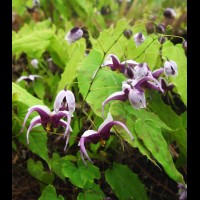
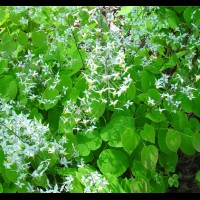
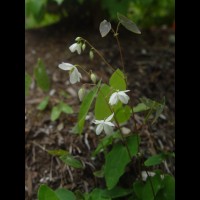
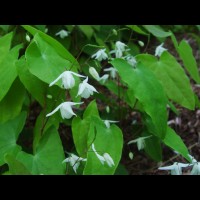
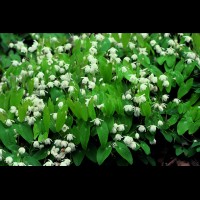
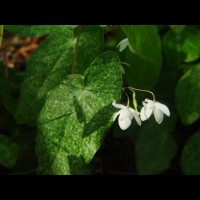
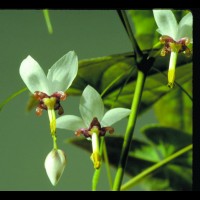
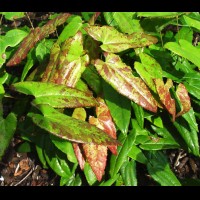
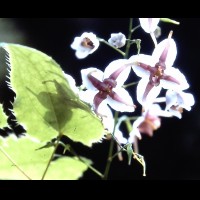
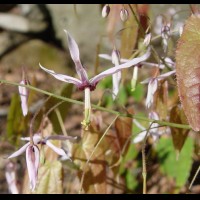
.jpg)
